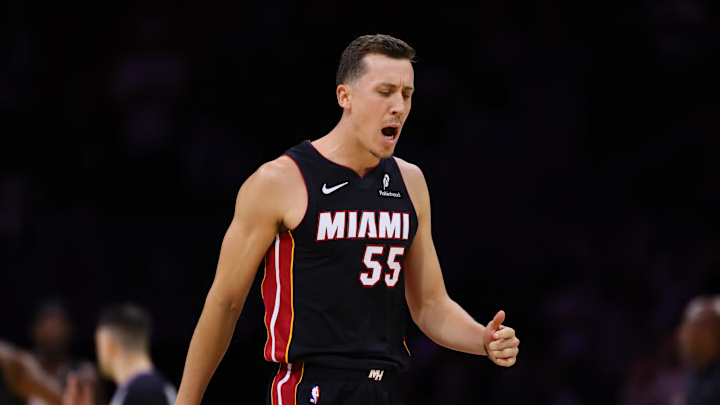How Many Teams Make the NBA Play-In Tournament?

The NBA’s play-in tournament first appeared on the scene in 2020, but its current iteration can be traced back to the 2021 season.
It was intended to increase the window size for teams to get into the playoffs and to discourage tanking across the league.
And, in large part, those two things have occurred. We’ve seen teams attempting to avoid the play-in games entirely—resulting in big stars playing more games down the stretch and we’ve seen teams try to gear up for a run instead of shutting down shop in February.
How many teams qualify for the NBA play-in tournament?
Before the tournament, each NBA conference (East and West) would be seeded No. 1 through No. 8. Those eight teams would play in best-of-seven series until a conference champion was crowned. That team would then play the other conference champion in the NBA Finals.
Now, 10 teams are involved in the playoffs after the conclusion of the regular season.
The teams seeded No. 7 through No. 10 in each conference will compete for the final two playoff berths (the No. 7 and No. 8 seeds).
So with 20 total teams in the playoff field, you can see why the league thought it would create more competition down the stretch.
But how do those extra games work?
NBA play-in tournament format
Both conferences participate in the tournament. The No. 7 seeds will play the No. 8 seeds, with the winners of those games being awarded the No. 7 seed for their respective conference. The loser of that game will play the winner of the No. 9 seed vs. No. 10 seed game for the opportunity to become the No. 8 seed.
Example play-in tournament structure:
Seed | Matchup | Outcome |
|---|---|---|
7 vs. 8 | Winner secures No. 7 seed | Loser plays winner of 9 vs. 10 |
9 vs. 10 | Winner advances | Loser elminated |
7/8 loser vs. 9/10 winner | Winner secures No. 8 seed | Loser eliminated |
How teams qualify for the NBA play-in tournament
Teams qualify for the tournament the same way they qualify for the rest of the playoffs—by their standings/record.
The top six teams in each conference are seeded No. 1 through No. 6 based on their record in the regular season. If two teams have the same record, the NBA has a list of tiebreakers. Those are:
- Head-to-head record. If that still results in a tie,
- The higher seed will be given to a team that won its division. If both teams (or neither) are division winners, then,
- Win-loss record against other teams within their division will be used.
So once the top six teams are seeded appropriately, the final four teams are seeded in the tournament.
The teams that finished seventh through 10th in their conference make the tournament, with the same tiebreakers listed above being used in the event of a tie.
How the play-in tournament impacts the NBA playoffs
While one might think that the tournament ultimately wouldn’t mean much, that hasn’t been the case thus far.
Despite being filled with lower-seeded teams, the tournament has sent multiple teams to the conference finals.
In 2023, the No. 7 Miami Heat lost to the No. 8 Atlanta Hawks, meaning the team had to play the No. 10 seed Chicago Bulls to secure the last seed in the playoffs. So Miami, which entered as the No. 7 but finished as the No. 8, went on to defeat top seed Milwaukee in five games.
Miami made it all the way to the NBA Finals, losing to the Denver Nuggets.
That same season, the Lakers also went from the tournament to the Western Conference Finals.
The No. 7 Lakers defeated the No. 8 Timberwolves, to secure the No. 7 seed before defeating the Grizzlies and Warriors to reach the Western Conference Finals.
History of the NBA play-in tournament
The NBA play-in tournament was originally conceived by the NBA Board of Governors during the 2019–20 season. It was part of the league’s plan for “The Bubble” during the pandemic and it was structured as follows:
If the No. 8 seeds and the No. 9 seeds in either conference were within four games of one another, those two teams would play. The No. 8 seed needed to win only one game head-to-head to make the playoffs, while the No. 9 seed would need to win twice.
This scenario only applied to the Western Conference that year, as the Memphis Grizzlies finished just one-half game behind the Portland Trail Blazers.
As a result, Portland and Memphis played an additional game. The Trail Blazers won 126–122, advancing as the Western Conference’s No. 8 seed.
In each year since, the format has changed to what we’ve been breaking down, with 10 teams from each conference getting in.
In 2021, the No. 9 seed Grizzlies advanced through the tournament to secure the No. 8 seed in the Western Conference, but lost in the first round to the Utah Jazz.
In 2022, two No. 9 seeds—the Hawks and New Orleans Pelicans—won two games in the tournament to become the No. 8 seeds. Both lost in the first round.
In 2023, the Heat lost their first game before winning the next two to become the Eastern Conference’s No. 8 seed. They went on to make the NBA Finals. That same season, the Lakers went from the tournament to the Western Conference Finals.
Last season saw the Pelicans and Lakers finish as the No. 7 and No. 8 seed, respectively. But after L.A. defeated New Orleans, the teams swapped seeds for the playoffs with the Lakers becoming seventh.
Notable teams that made the playoffs through the NBA play-in tournament
Really, the most notable team to go from tournament to Finals contender was the Heat in 2023.
Miami had struggled from three-point range all season long, but found its deep stroke in the playoffs, shooting 38% from behind the arc.
Jimmy Butler truly put the franchise on his back, and seemingly every Miami role player had at least one moment during the team’s run to the NBA Finals.
Butler averaged 27 points, six assists and 6.5 rebounds to buoy a Heat team without Tyler Herro.
Ultimately, the Heat just didn’t have the talent to compete with the Nuggets in the NBA Finals.
Why the NBA introduced the play-in tournament
The NBA wanted to address a lack of interest down the stretch of the regular season. This should, in theory, be some of the most-watched basketball of the entire year, but it wasn’t quite panning out that way.
There were a few factors at play—the team’s at the top of each conference were wrapping up their top seed or two fairly early, then getting selective about playing their stars. Plus, teams that didn’t think they had a real shot at a playoff run were tanking to get a better draft pick.
So between the top-end teams pulling their punches and the bottom-end teams sort of quitting, we were getting some not-so-great basketball to end the regular season. Of course that wasn’t always the case, but the NBA wanted to make things more competitive.
Now, teams that are fighting for the No. 5 or No. 6 seeds have a real incentive to stay there. They don’t want to be playing extra games. But at the same time, you’ve got teams scratching and clawing for a chance to get in at the No. 9 or No. 10 spot.
While some might not like it, the tournament isn’t going anywhere anytime soon—because it is accomplishing exactly what the NBA wanted it to.
More NBA on Sports Illustrated
feed
